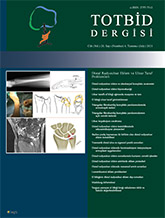
Ulnar impaction syndrome is one of the common causes of ulnar sided wrist pain. It is a pathology developing due to the compression of the ulnar head with the carpal bones and the triangular fibrocartilage complex structure. The most common cause of this compression is the presence of positive ulnar variance. Ulnar deviation, pronation and grasping movements increase the ulnar variance and impaction, and consequently the symptoms are exacerbated. Since ulnar variance is a condition that changes with movements, it is important to do the imaging with radiography in the neutral wrist position. With the help of magnetic resonance imaging, cartilage degeneration and bone marrow edema are observed in the joint surfaces where impaction is present. In ulnar impaction syndrome, the edema in the lunate bone does not show a diffused distribution pattern as in Kienböck`s disease, but is on the joint surface adjacent to the ulna. Conservative methods are the initial treatments to be conducted in ulnar impaction syndrome. Surgical treatment is an option that should be applied in patients who have clinically and radiologically diagnosed with ulnar impaction syndrome, who did not benefit from conservative treatment and develop distal radioulnar joint arthrosis. Ulnar shortening osteotomy and wafer resection are the most preferred surgical methods. The purpose of these two surgical methods is to provide decompression in the ulnocarpal joint where there is overload.